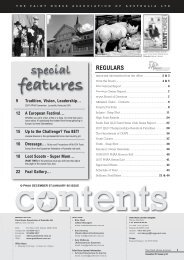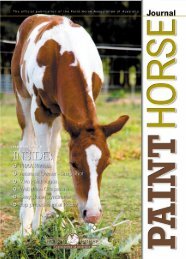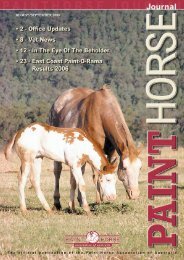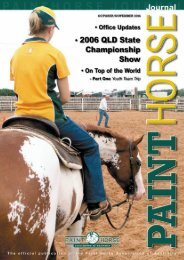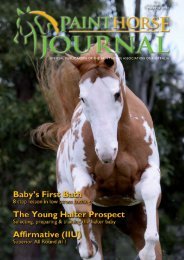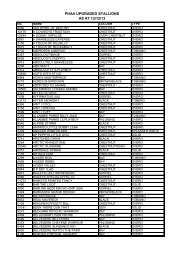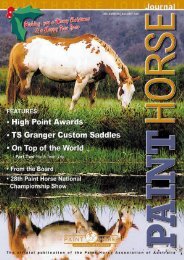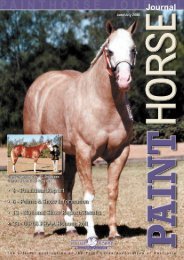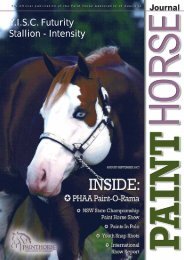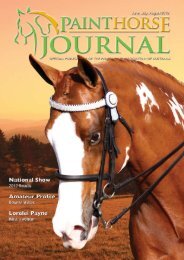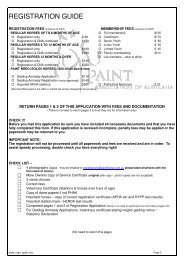PaintHorseJournal-2009-Dec:Layout 1 - Paint Horse Association of ...
PaintHorseJournal-2009-Dec:Layout 1 - Paint Horse Association of ...
PaintHorseJournal-2009-Dec:Layout 1 - Paint Horse Association of ...
Create successful ePaper yourself
Turn your PDF publications into a flip-book with our unique Google optimized e-Paper software.
Walnut Hall's vet, Joe Lyman, DVM, based the technique<br />
on presentations by Peter Daels, DVM, PhD, and John<br />
Steiner DVM, Dipl. ACT. Using their methods, not only<br />
can unbred mares that have previously had at least<br />
one foal be persuaded with medication to produce<br />
milk, but the procedure also seems to stimulate maternal<br />
behavior, greatly simplifying the tricky process<br />
<strong>of</strong> getting a nurse mare to adopt an orphan foal. For<br />
an operation like Walnut Hall, which uses nurse<br />
mares routinely, it was a revolutionary idea.<br />
"We breed to a lot <strong>of</strong> New York-based stallions,"<br />
Lyman explained, "and New York state laws prohibit<br />
semen being shipped out <strong>of</strong> state. So we have to ship<br />
our mares to them, and that has usually meant leaving<br />
the foals behind with nurse mares, rather than<br />
putting them through the stress <strong>of</strong> shipping." Farm<br />
owners Alan Leavitt and his wife, Meg Jewett, have<br />
always been uncomfortable with the usual method<br />
<strong>of</strong> deliberately breeding mares, then<br />
removing their foals to make the dams<br />
available as nurse mares, he added, so<br />
this protocol presented a new opportunity.<br />
Shortly after his return from the<br />
Orlando meeting, Lyman began sourcing<br />
mares from adoption and rescue organizations,<br />
such as the New Vocations<br />
Racehorse Adoption Program in Ohio.<br />
"We adopted 22 mares, mostly Standardbreds,<br />
with a few Thoroughbreds<br />
and a couple <strong>of</strong> Quarter <strong>Horse</strong>s," he<br />
said. "The only real criterion was that they had raised<br />
foals previously and were good mothers. Maiden mares<br />
don't respond well to this protocol. "We even used a<br />
couple <strong>of</strong> our own mares that we'd retired from breeding<br />
due to reproductive problems, giving them a job<br />
again," he added.<br />
Walnut Hall used a simplified drug protocol based on<br />
a once-a-day administration <strong>of</strong> an oral domperidone<br />
gel (a dopamine antagonist which increases milk production<br />
in mares and is also used to combat fescue<br />
toxicity). "If they're going to lactate, you'll know within<br />
three to four days, usually," Lyman said. "They'll start<br />
producing watery milk, and you'll see the bag start to<br />
fill. Most mares were in decent milk production within<br />
10 days." Twenty <strong>of</strong> the 22 mares responded to the<br />
lactation protocol. When it came time to introduce<br />
the foster foals, Walnut Hall administered a shot <strong>of</strong><br />
oxytocin and prostaglandin to each mare, along with<br />
some mild sedation. This was followed by a vaginal/<br />
cervical massage, which Daels had found to be key to<br />
stimulating a maternal response.<br />
"It was pretty neat," Lyman said.<br />
"Within a couple <strong>of</strong> minutes <strong>of</strong> doing<br />
the cervical massage, the mares would<br />
lower their heads and start nickering<br />
to the foal. It's a response called the<br />
Ferguson reflex. Sixteen <strong>of</strong> the 20<br />
mares accepted their foals within half<br />
an hour, and the longest (time period)<br />
was a day. All 20 mares had accepted<br />
their foals within 24 hours. If you've<br />
dealt with nurse mares, you know<br />
that's an amazing success rate."<br />
Since the induced lactation doesn't stimulate the production<br />
<strong>of</strong> colostrum (a sticky milk, high in protein and<br />
antibodies, secreted during the first 24 hours following<br />
birth), Walnut Hall found that foals aged seven to eight<br />
days were the most likely to thrive under the care <strong>of</strong><br />
their nurse mares. "At weaning, you couldn't tell the<br />
difference. They were all big, robust kids, and their<br />
OCD (osteochondrosis dissecans) rates were similar<br />
to the foals raised by their own dams," said Lyman.<br />
"This is so much better than breeding nurse mares<br />
and ending up with unwanted foals," he added. "And<br />
the mares get a good deal out <strong>of</strong> it – they get a good<br />
life on the farm, a much better fate than they might<br />
otherwise have had."<br />
Reprinted with permission <strong>of</strong> copyright owner The <strong>Horse</strong>;<br />
visit www.The<strong>Horse</strong>.com for more horse health information.<br />
<strong>Dec</strong>ember <strong>2009</strong>/January 2010 | PAINT HORSE JOURNAL 29



